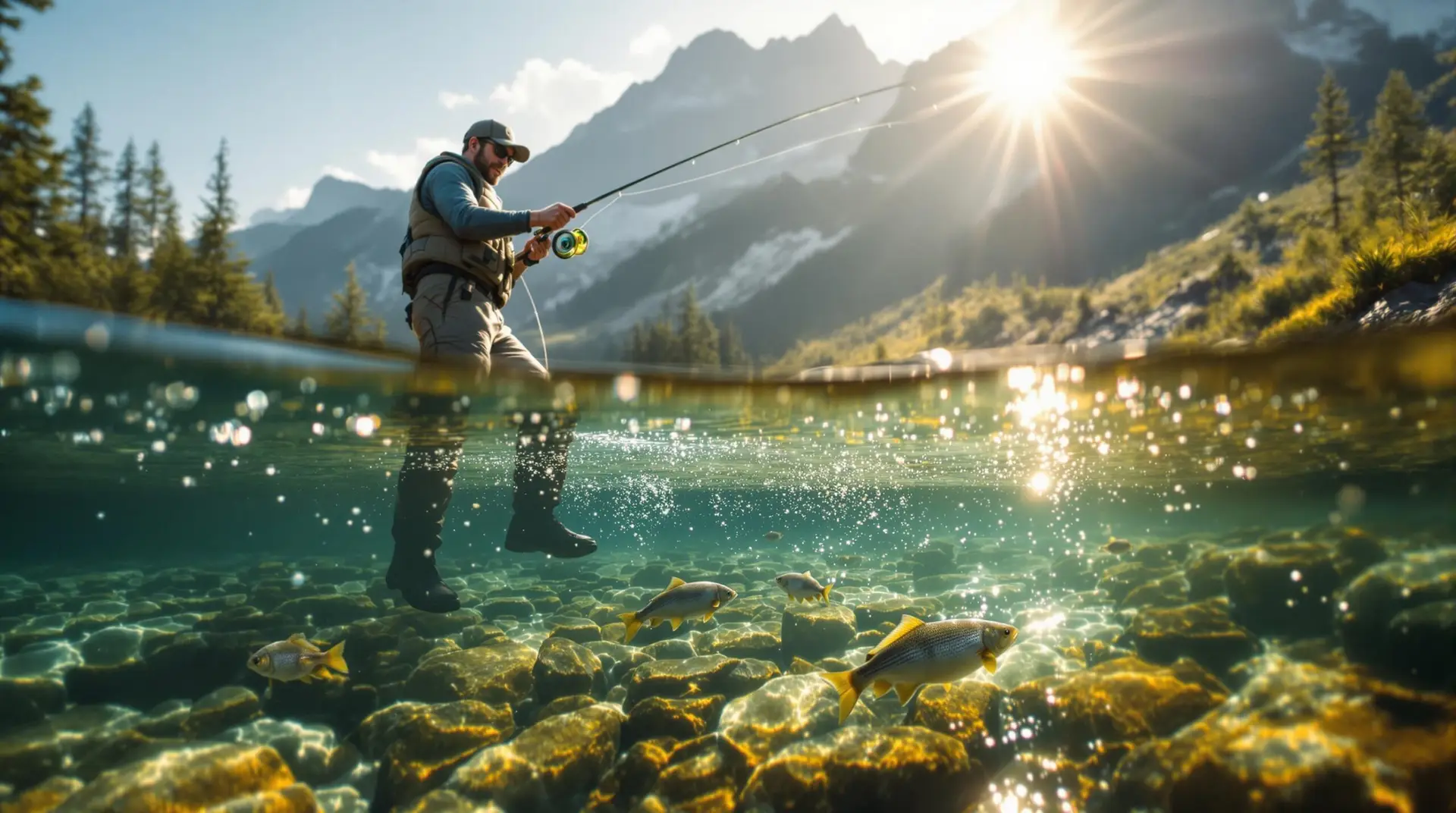French Nymphing Techniques
Evolution of French Nymphing
French nymphing is not just a fancy way of fishing; it’s an art born out of necessity during the World Fly Fishing Championship when anglers in France had to deal with shy fish and clear rivers. Imagine trying to catch a fish that could see your every move! So, the clever folks developed techniques and gear to be sneaky and precise. They’ll use stuff like a long rod, a slim leader, and a piece of coiled mono called a “slinky” to feel even the tiniest nibbles. With this, catching those finicky trout that usually give you the cold shoulder becomes way easier.
Components of French Nymphing
Getting into the nitty-gritty of French nymphing means knowing your tools: the right leader setup, the proper rod, and the ideal reel. Together, these things make your fishing game strong.
Leader Setup
The leader in French nymphing isn’t your run-of-the-mill rig. It’s about 18 to 20 feet long, with a tapered beginning, that sneaky “slinky,” and a tippet. Expert anglers, especially from Fly Fishing Team USA, tweak the colors, lengths, and strengths to suit their ways, each believing they’ve found the secret sauce (Fly Fisherman). Usually, you’ve got 10 to 12 feet of fine-tuned hand-tied leader, slimmed down to a 12 or 15-pound test. It’s about keeping that line tight and not letting the fish get the upper hand.
Key Components of the French Nymphing Leader
| Component | Typical Length | Test |
|---|---|---|
| Hand-tied Leader | 10 – 12 feet | 12 – 15 lb |
| Coiled “Slinky” | Changes | None |
| Tippet | Changes | Varies |
Rod Selection
A long rod is where it’s at for French nymphing. Something between 10 and 11 feet gets you the reach and control needed for spot-on casting. With this length, you can keep most of your line out of the water to dodge drag and let your fly float naturally, kind of like it’s doing its own thing.
Reel Considerations
A reel with a wider diameter matches up well for this style, even if you’re not casting much line (Czech Nymph). You can use any backing since it’s more about the leader. The real magic happens when the reel’s weight is just right for the rod—comfort and efficiency all day long.
To really get the hang of French nymphing, check out more on advanced euro nymphing. Skills like contact nymphing techniques, nymph drift mechanics, and deep water nymphing will have you fishing like a pro.
Gear and Equipment
Getting the right gear can seriously boost your Euro nymphing skills. Here, we’re diving into the basics every serious nymph angler needs to know: rods, leaders, and reels.
Rod Selection
Picking out the right rod makes all the difference when you’re working those French nymphing moves. Longer rods that stretch between 9 1/2 to 10 feet are usually recommended. These bad boys typically have a softer tip, which is awesome because it helps with your casting accuracy while keeping fish hooked without breaking that oh-so-delicate tippet. Here’s the lowdown:
| Length | Typical Weights | Tip Action | Best For |
|---|---|---|---|
| 9 1/2 – 10 feet | 2-4 weights | Moderate to soft | Precision casting, controlling drift, wrestling fish |
If you’re targeting smaller fish, grab an AFTM 3 rod. If you’re taking on bigger fish or chilling in fast waters, an AFTM 4 rod’s your guy. Check out our guide on the best Euro nymphing rods for more ideas.
Leader Setup
A solid leader set-up can make or break your French nymphing success. It should usually stretch between 18 and 20 feet, with a mix of a tapered leader, a coiled “slinky,” and a tippet (Fly Fisherman). This setup is crucial for staying in touch with the fly and picking up bites.
| Component | Length | Material | Purpose |
|---|---|---|---|
| Tapered Leader | 18-20 feet | Variable | Smooth transition of energy |
| Slinky | Variable | Coiled polymer | Visual cue for strikes |
| Tippet | Varies | Fluorocarbon or nylon | Connects flies to leader |
Still puzzled? Swing by our article on nymphing leader setup for step-by-step guidance.
Reel Considerations
When choosing a reel, go for one with a larger diameter. A wider reel makes it easy to pull in line fast and balances out those longer rods. Mostly, the reel serves as a storage spot for the line since it’s the leader that does the heavy lifting during the fishing (Czech Nymph).
| Feature | Specification | Benefits |
|---|---|---|
| Diameter | Wider | Quick line retrieval, superior balance |
| Material | Lightweight | Less arm strain |
| Drag System | Smooth and adjustable | Tames the bigger fish |
Need more insights? Visit our page on best comp nymphing lines.
With the right gear, you’re not just fishing, you’re stepping up your nymphing game big time. For more handy tips and techniques, check out our complete guide on advanced Euro nymphing.
Mastering French Nymphing
Casting Techniques
When it comes to French nymphing, it’s all about keeping things precise and staying in touch with your fly. It’s a different beast compared to your granddad’s traditional fly fishing. You’re dealing with casting a super-long 18-to-20-foot leader but hardly any fly line (Fly Fisherman). This new way helps the nymph drift better and lets you feel even the tiniest nibble from the fish.
The secret sauce? A good tapered leader and the weight of your flies. Toss in a dash of arm-lifting magic as you cast, keeping that coiled mono section riding just on the water’s edge. This way, you’re not just winging it; you’re aiming like a pro and getting those flies right where they need to be.
Check out a standard French nymphing leader setup for casting:
| Component | Length | Description |
|---|---|---|
| Main Tippet | 18-20 feet | Fluorocarbon or monofilament |
| Tapered Leader | 6-9 feet | Knotless tapered design |
| Weighted Nymph(s) | 1-2 flies | Tungsten beads for added casting weight |
To nail it, keep practicing with barely any line out there. Focus on a smooth, straight path and make sure your line’s tight with those nymphs.
Detecting Takes
Catching fish in French nymphing is like being a detective. Without your usual bobbers, you’re all about the feel and the look. So, keep that leader tight and your mono section just skimming the water to feel when a fish takes a bite.
Presentation Skills
How you show off your fly in the water can make all the difference. In French nymphing, it’s all about making the nymph look like it’s chilling naturally underwater. Here’s how you ace it:
- Stay Connected: Right after your cast, stretch out that rod and keep a solid connection with your flies (Fly Fisherman).
- Rod Tricks: Hold the rod tip up high and follow along with the drift. Keep that leader off the water, reducing drag and making everything look more, well, fishy.
- Maneuver Your Line: Keep your line nice and taut by moving the rod and leader around. Lead those flies gently with your rod tip as they meander.
Want to dive deeper into how to euro nymph? Check out our special resource collection.
For those looking to level up, take a gander at articles about the contact nymphing technique, nymph indicator techniques, and advanced euro nymphing.
Advanced Strategies
Getting skilled at French Nymphing goes beyond just knowing the basics. For those already handy with a fly rod, it’s about perfecting the little things—like mastering different casts, nailing depth control, and dealing with whatever curveballs nature throws at you. These tweaks can make your fishing game way sharper with this method.
Upstream vs. Across Casting
You can do French nymphing either by casting straight upstream or at a bit of an angle across. These methods score big time in those 2 to 5-foot deep riffles and runs (Fly Fisherman).
Upstream Casting
- What’s Good About It: Sharpness. You’re ready to set the hook immediately, there’s no loose line hanging about.
- When to Use: Quick streams and shallower waters are its playground.
Across Casting
- What’s Good About It: It’s got a wider reach—perfect for areas where you need to scope out what’s happening over different depths and water speeds.
- When to Use: Handy for those big, middle-of-the-road depth areas.
Depth Control Techniques
Getting the depth just right is a biggie in French Nymphing. Nail it, and your nymphs sit snug in the strike zone, upping the odds of catching a bite.
- Rod Placement and Angle
- The way and angle you hold your rod plays dictator on how deep a nymph sits.
- Higher angles usually mean the nymphs hang closer to the top; drop that rod for a deeper dive.
- Weight Adjustment
- Switch up with tungsten beads and adjust how heavy your nymph rigs are (best tungsten beads nymphing) to hit your target depth.
- Toss in a variety of multiple nymph rigs (multiple nymph rigs) to juggle those lures at different water depths.
- Current Seam Analysis
- Spot those current seams and let your nymphs drift like the water’s carrying them.
- Fiddle with your drift mechanics (nymph drift mechanics) to keep nymphs hanging out longer in the strike zone—keeps the chances of a catch high.
Overcoming Challenges
With French Nymphing, there’ll be bumps in the road. How you tackle these can make or break your fishing day.
- Variable Water Conditions
- Adjust your casting techniques when water speeds up or plays deep.
- Lean on those longer rods (like 9 1/2 to 10 feet), which give you both subtlety and accuracy.
- Detecting Takes
- French Nymphing shines at catching those subtle bites. Keep that coiled mono section just peeking above the water for a step up over those old-school indicators.
- Dive into contact nymphing techniques (contact nymphing technique)—helps cut slack and get hooks set right away.
- Managing Slack
- Keeping your line tight is key; it helps you hook up quick without much rod movement.
- Consider shaking up your approach with competition nymphing practices (competition nymphing) to smooth out your line handling skills.
Fine-tuning these strategies pumps up your French Nymphing game, setting up expert fly fishers for more wins on the water. For a deeper dive, don’t forget to check out articles on how to euro nymph, advanced euro nymphing, and deep water nymphing.

